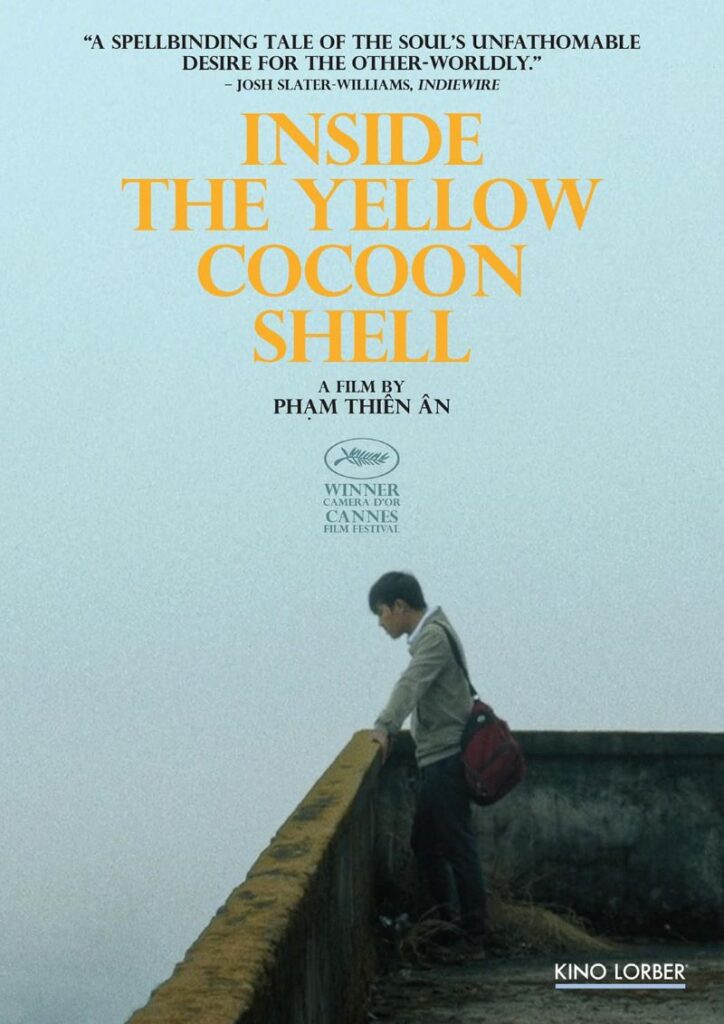
This award-winning entry from last year’s Cannes Film Festival takes viewers on a mournful quest through present-day rural Vietnam. As written and directed by Pham Thien An, his debut feature film revolves around a young man’s attempt to help his five-year-old nephew after the sudden death of his sister-in-law, the boy’s mother.
Buy Inside the Yellow Cocoon Shell DVDThe young man is named Thien, the younger brother of the nephew’s father. His brother has been missing for years after ditching his rural wife and child to go to the big city of Saigon in search of fortune. When his nephew is left with no mother and a long-absent father, Thien takes him in and sets out on a trip to try to track down his long-lost brother. We follow along as Thien and his nephew pursue scraps of leads pointing to the whereabouts of their target, moving through small and medium towns on their scenic trip. The story follows a long and winding road, but not any typical road one might expect, and with no certain destination.
The film is three hours long, not because Pham has any intricate plot to develop, but solely because he seems to hate the off button on his camera. Scenes drag on endlessly for no reason, such as what seems like minutes of a rooster crowing until actors finally enter the frame, or Thien silently loitering outside a building in the hopes his brother will arrive. Pham is in desperate need of an editor, as he’s clearly too invested in his material to objectively edit it himself.
Likewise, he could benefit from some writing assistance, as the structure of this film is so loose that its random ending is completely anticlimactic. Character development is nearly non-existent, with Thien drifting from one chance encounter to the next in his lackadaisical voyage to an uncertain future. There’s something to be said for decompressed storytelling that allows scenes ample room to breathe, but not when those scenes have so very little payoff.
His actors legitimately seem like typical rural denizens, which is great for authenticity but not so much for dramatic performances. As Thien, Le Phong Vu barely emotes, maintaining only a base level of engagement with other actors no matter the increasingly dire situation facing his nephew. The only time he comes even a tiny bit undone is when the character rents a karaoke room by himself to drown his sorrows in song and booze. The other characters he meets are played by similarly bland actors, making their interactions entirely uninvolving, although the young nephew is adequately adorable.
So how did Pham win the Camera d’Or award at Cannes for best first feature? Two reasons appear most likely. First, the film is an exceedingly rare look at the “real” modern-day Vietnam, not the typical focus on the big city of Saigon/Ho Chi Minh City or the endless shots of unpopulated rice paddies favored by every Vietnam War movie. Pham takes us deep into the hinterlands of rural small- to mid-sized towns, showing a bustling but still pastoral countryside. The citizens obviously don’t have much money or opportunity, but they have enough to enjoy life in their small towns, much like rural demographics in every culture including ours. This setting adds to the universal appeal of the film, showing us life not that much different than our own country cousins, but flavored with a unique cultural perspective.
Second, working with his director of photography, Ding Duy Hung, he strings together two outstanding continuous shots that signal an unexpectedly high level of technical finesse. The first is the opening shot of the film, showing us an evening soccer match in action before panning to the right to join a group of chatty friends having drinks, then panning further to the right after a vehicular crash occurs offscreen, revealing a horrific accident that sets up the entire plot. The second even more astounding shot occurs around the middle when Thien is in the country searching for clues to his brother’s location. He asks his host for directions to an elder who may have clues, then borrows the host’s scooter to ride to the elder’s home a couple of minutes away over shoddy dirt roads, then enters the home to carry out his queries, with the camera smoothly following along for the whole ride and zooming in through the window to be a fly on the wall for the conversation. I still can’t figure out how they did it.
Pham establishes himself as a creator to watch, but hopefully in a much more focused story and edit the next time around. The DVD presents the film in 1.85:1 aspect ratio with Dolby 5.1 surround, enveloping viewers in the ambience of the countryside. No bonus features are included.
Inside the Yellow Cocoon Shell releases on DVD on March 19th.